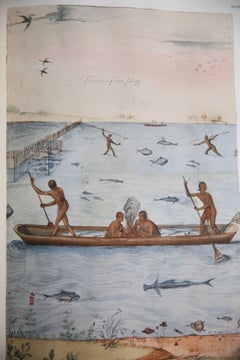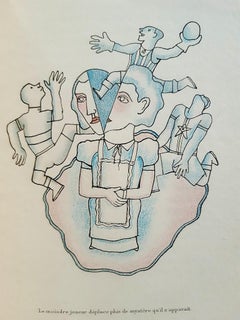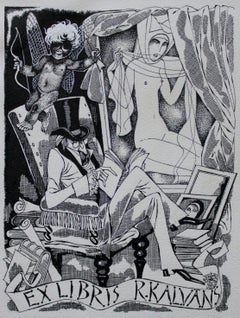John White (b.1540) Figurative Drawings and Watercolors
to
1
1
1
888
324
192
178
1
Artist: John White (b.1540)
The American Drawings of John White, 1577-1590
By John White (b.1540)
Located in New York, NY
Title: The American Drawings Of John White, 1577-1590:
With Drawings Of European And Oriental Subjects. 2 Vols.
Vol. I. A Catalogue Raisonne And A Study Of The Artist.
Vol. II. Rep...
Category
1960s Realist John White (b.1540) Figurative Drawings and Watercolors
Related Items
Le Secret Professionnel - Vintage Rare Book Illustrated by Jean Cocteau - 1925
By Jean Cocteau
Located in Roma, IT
Le Secret Professionnel is an original modern rare book illustrated by Jean Cocteau (Maisons-Laffitte, 1889 – Milly-la-Forêt, 1963) in 1925.
Published by Au Sens Pareil, Paris.
Original Edition.
530 numbered copies, one of the 440 copies on vélin d'Annonay.
Format: in 8°.
The book includes 105 pages with Twelve full page color drawings.
Mint conditions.
Jean Cocteau (Maisons-Laffitte, 1889 – Milly-la-Forêt, 1963). Jean Maurice Eugène Clément Cocteau was one of the most famous French writer, designer, playwright, artist and filmmaker. The novel Les Enfants Terribles (1929) and the films Blood of a Poet (1930), Les Parents Terribles (1948), Beauty and the Beast (1946) and Orpheus (1949) are his most appreciated works. His circle of friends, lovers and colleagues included Kenneth Anger...
Category
1920s John White (b.1540) Figurative Drawings and Watercolors
Materials
Paper
$2,690
H 9.34 in W 6.89 in D 0.2 in
Ex Libris 1982, paper, ink, gouache, 17.5х13 cm
Located in Riga, LV
Ex Libris
1982, paper, ink, gouache, 17,5х13 cm
Information about artist:
Gunārs Vīndedzis (1918 - 1991) - cartoonist, illustrator.
Born in a fami...
Category
1980s Realist John White (b.1540) Figurative Drawings and Watercolors
Materials
Paper, Ink, Gouache
$287 Sale Price
20% Off
H 6.89 in W 5.12 in D 0.08 in
Old Master Drawing, Baroque, Jacob de Wit, Allegory of Victory, Putti, Ships
By Jacob De Wit
Located in Greven, DE
Two putti with symbols of war and victory (cannons, cannonballs, armour, anchor, lion's head, laurel branch/ olive branch, flag, staff with helmet) in pediment triangle.
Probably a design for a painting or architecture
Pen-and-ink drawing in black on brownish paper, black wash
Plain gold moulding with UV glass
Allegory of Victory, 18th Century, Old Master Drawing, By De Wit, Figurative
Jacob de Wit...
Category
Late 17th Century Baroque John White (b.1540) Figurative Drawings and Watercolors
Materials
Paper, Crayon
$2,176 Sale Price
35% Off
H 8 in W 12.8 in
Putti in a Landscape, Putti playing, flowers, Berchet, French Art, Old Master
By Pierre Berchet
Located in Greven, DE
Pierre Berchet, Drawing of Putti playing in a landscape,
Painter of decorative history subjects; trained under La Fosse; worked in France and during the 1690s...
Category
17th Century Baroque John White (b.1540) Figurative Drawings and Watercolors
Materials
Handmade Paper
$1,722 Sale Price
20% Off
H 8.12 in W 12.09 in
Circle of Angelika Kauffmann, Venus and Amor, Arrow and Spindle, Oval Drawing
Located in Greven, DE
Fine drawing in pencil, oval format. Circle of Angelika Kauffmann.
The subject is not clear. It is Amor with his arrows and perhaps Venus with a sp...
Category
18th Century Romantic John White (b.1540) Figurative Drawings and Watercolors
Materials
Crayon, Handmade Paper
$1,148 Sale Price
20% Off
H 11.3 in W 9.06 in
Mid Twentieth Century Impressionist Style Watercolour Portrait of Young Man
By Edward Seago
Located in ludlow, GB
Mid Twentieth Century Impressionist Style Watercolour Portrait of the Young Child Actor Jeremy Spenser by Edward Seago.
Edward Seago is most likely the most famous Twentieth Century...
Category
Mid-20th Century Post-Impressionist John White (b.1540) Figurative Drawings and Watercolors
Materials
Watercolor
$10,345
H 20 in W 16 in D 1 in
Neues Album - Rare Book Illustrated by Wilhelm Busch - 1925
Located in Roma, IT
Neues Album is an original modern rare book illustrated by Wilhelm Busch (Wiedensahl, 15 aprile 1832 – Mechtshausen, 9 gennaio 1908) in 1925.
First augm...
Category
1920s John White (b.1540) Figurative Drawings and Watercolors
Materials
Paper
$538
H 12.6 in W 10.24 in D 0.79 in
The History of Amelia - Rare Book Illustrated by George Cruikshank - 1832
By George Cruikshank
Located in Roma, IT
The History of Amelia is an original modern rare book engraved by George Cruikshank (London, 1792 – London, 1878) and written by Henry Fielding in 1832.
Published by James Cochrane ...
Category
1830s John White (b.1540) Figurative Drawings and Watercolors
Materials
Paper, Etching
$298
H 6.7 in W 4.34 in D 0.2 in
Jonas Wood Original unique signed Flower drawing, to Kevin in hardback monograph
By Jonas Wood
Located in New York, NY
Jonas Wood
Original flower drawing by the artist held in hardback book, 2018
Hardback Monograph.
Hand signed, dated and inscribed with unique drawing by Jonas Wood on the title page....
Category
2010s Contemporary John White (b.1540) Figurative Drawings and Watercolors
Materials
Mixed Media, Permanent Marker, Offset
$2,000
H 10.25 in W 8.25 in D 0.75 in
Theatre Scene, Opera, Old Master Drawing, Griselidis, Mallet, French Art
Located in Greven, DE
Unknown Artist, French School 18th Century, Circle of Mallet? Scene taken from the Decamerone.
Old Master Drawing
Category
18th Century Romantic John White (b.1540) Figurative Drawings and Watercolors
Materials
Paper, Cardboard
$1,435 Sale Price
20% Off
H 21.74 in W 26.93 in
Citroen 15CV - Contemporary Watercolor & Ink Painting, Vintage Car, Realistic
By Mariusz Szałajdewicz
Located in Warsaw, PL
Mariusz Szalajdewicz (b. 1974)
Studied at the Faculty of Architecture at Warsaw University of Technology, where he mastered the drawing skill. Architect and urbanist, illustrator.
Category
21st Century and Contemporary Realist John White (b.1540) Figurative Drawings and Watercolors
Materials
Paper, Ink, Watercolor
Untitled Figurative by Miguel Conde, No. 102/150
By Miguel Conde
Located in San Diego, CA
Signed lithograph by awarded artist Miguel Conde. The artist is known for his mastery of engraving. His drawings and other art forms are sought after and his artwork is part of vario...
Category
20th Century Expressionist John White (b.1540) Figurative Drawings and Watercolors
Materials
Paper
$1,180 Sale Price
20% Off
H 29.25 in W 23.5 in D 1 in
John White (b.1540) figurative drawings and watercolors for sale on 1stDibs.
Find a wide variety of authentic John White (b.1540) figurative drawings and watercolors available for sale on 1stDibs. Customers who are interested in this artist might also find the work of Mariusz Szałajdewicz, Rosy Andreasi-Verdier, and Gustave Poetzsch. John White (b.1540) figurative drawings and watercolors prices can differ depending upon medium, time period and other attributes. On 1stDibs, the price for these items starts at $400 and tops out at $400, while the average work can sell for $400.


